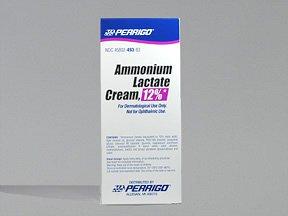Why is this medication prescribed?
Both xerosis (dry, scaly skin) and ichthyosis vulgaris (an hereditary dry skin disorder) in adults and children are treated with ammonium lactate. Ammonium lactate belongs to the group of drugs known as alpha-hydroxy acids. It increases skin moisture in order to work.
How should this medicine be used?
Ammonium lactate is available as a cream and lotion for topical use. It is typically administered twice daily to the afflicted skin area. Apply ammonium lactate every day at around the same time(s). Ask your doctor or pharmacist to explain any instructions on your prescription label that you are unsure about following. Follow the directions properly when using ammonium lactate. Use it only as directed by your doctor, neither more nor less often.
Before each use, thoroughly shake the lotion container to combine the medication.
Apply a tiny amount of cream or lotion to the skin’s affected region and gently rub it in to utilise ammonium lactate topical.
Only the skin should be used to apply this medication. Avoid getting ammonium lactate topical in your mouth, nose, or vagina and never ingest it.
Contact your doctor if your skin issue gets worse while receiving therapy.
Other uses for this medicine
Ask your doctor or pharmacist for more details if you believe this drug should be used for something else.
What special precautions should I follow?
Before using ammonium lactate,
- If you have an allergy to ammonium lactate, any other drugs, or any of the substances in ammonium lactate cream or lotion, let your doctor and pharmacist know right once. Request a list of the components from your pharmacist.
- Inform your doctor and pharmacist about any additional prescription and over-the-counter drugs, vitamins, dietary supplements, and herbal products you are now taking or intend to use. Your physician might need to adjust the dosage of your drugs or keep a close eye on you for side effects.
- If you are breastfeeding a child or intend to become pregnant, let your doctor know. Call your doctor if you become pregnant while taking ammonium lactate.
- Plan to use protective clothing, sunglasses, and sunscreen as well as to avoid unnecessary or prolonged exposure to natural or artificial sunlight on the afflicted skin region. Your affected skin area may become sun-sensitive if you utilise ammonium lactate.
What special dietary instructions should I follow?
Keep eating normally unless your doctor instructs you otherwise.
What should I do if I forget a dose?
As soon as you realise you missed a dose, administer it. If the next dose is soon due, skip the missed one and carry on with your regular dosing plan. Applying extra cream or lotion to make up for a missed dose is not advised.
What side effects can this medication cause?
Side effects from ammonium lactate topical may occur. If any of these symptoms are severe or do not go away, let your doctor know right once:
- Stinging (particularly on damaged or broken skin) (especially on cracked or broken skin)
- Itching, burning, or redness of the skin
- Skin sensitivity (especially on the face)
- Rash
- Peeling skin
- Arid skin
Other negative effects of ammonium lactate are possible. If you experience any strange issues while taking this drug, call your doctor right away.
What should I know about storage and disposal of this medication?
Keep this medication tightly closed in the original container and out of the reach of children. Store it away from excessive heat and moisture at room temperature (not in the bathroom).
Unused prescriptions must be disposed of carefully to prevent pets, kids, and other people from ingesting them. You should not, however, dispose of this medication in the toilet. Instead, utilising a medicine take-back programme is the easiest approach to get rid of your medication. To find out about take-back programmes in your area, speak with your pharmacist or the garbage/recycling department in your city. If you do not have access to a take-back programme, see the FDA’s Safe Disposal of Medicines website at http://goo.gl/c4Rm4p for additional information.
As many containers (such as weekly pill minders and those for eye drops, creams, patches, and inhalers) are not child-resistant and are simple for young children to open, it is crucial to keep all medications out of sight and out of reach of children. Always lock safety caps and promptly stash medication up and away from young children where it is out of their sight and reach to prevent poisoning. http://www.upandaway.org
In case of emergency/overdose
Dial 1-800-222-1222 to reach your local poison control centre if someone has ingested ammonium lactate. Dial 911 to reach the nearest emergency services if the sufferer has collapsed or has stopped breathing.
What other information should I know?
Keep all of your doctor’s appointments.
Do not share your medication with anybody else. Any queries you may have regarding medication refills should be directed to your pharmacist. Call your doctor if your symptoms persist after using up all of your cream or lotion.
You should keep a written record of every medication you take, including any over-the-counter (OTC) items, prescription drugs, and dietary supplements like vitamins and minerals. This list should be brought with you whenever you see a doctor or are admitted to the hospital. You should always have this information with you in case of emergencies.
Brand names
- Lac-Hydrin


